|
The Fw 190 V1 in 1/24
First of the
Wurgers
by Frank Mitchell
|
 |
|
Focke-Wulf Fw 190
V1 |

Trumpeter's 1/24 scale Fw 190D-9 is available online from Squadron.com
What do you do when you realize that you have
accumulated three 24th scale Fw 190 kits (Two Airfix, and one Trumpeter
190D)? Obviously, you try to find something different to do with at
least one of them.
Like most modelers, I have a fairly large stack of
references on all the versions of the 190, and the more I looked, the
more I realized that the V1 was a very different airplane from even the
first production versions. For starters, it had a unique engine
installation (really unique in the early configuration), a cockpit that
was considerably forward of where it ended up, a heavily modified wing,
a smaller rudder and tailwheel, and a number of other changes.
All-in-all, it seemed like a typical Frank Mitchell
“let’s-do-everything-the-hard-way” project.
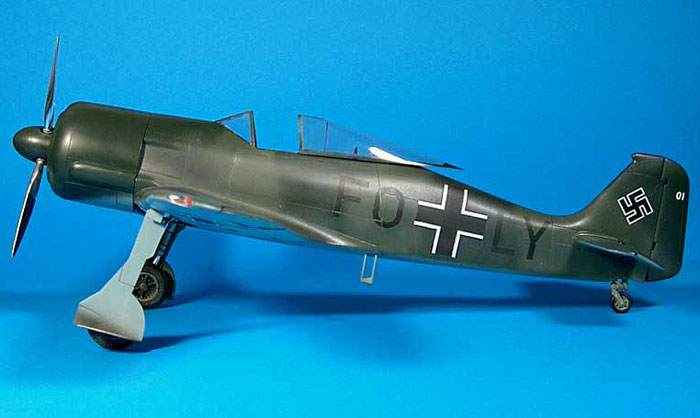
In common with most prototypes, detailed photos were a bit hard to come
by, but every book or magazine had one or more pictures, many of them
different, so I was able to get a fair collection of information. I
decided to build this model to represent the V1 in its final
configuration, after it was modified to, among other things, remove the
ducted spinner, which I have always thought looked kind of silly.
For construction of the model, the photos will
pretty well show the basics; I will just guide you through.
Beginning with the fuselage, the cockpit had to be moved about an inch
forward, and raised in the back. It was moved rearward in the production
model because A) the engine was changed from the BMW 139 to the BMW 801
(which was longer and changed the weight distribution of the aircraft),
B) to keep the pilot from being done to medium rare on every flight
(cockpit temperatures reached 130 F), and C) the decision to mount guns
above the engine.
The cowling was therefore very different from
production versions, so a mold was turned from basswood and a new one
vacuum-formed.
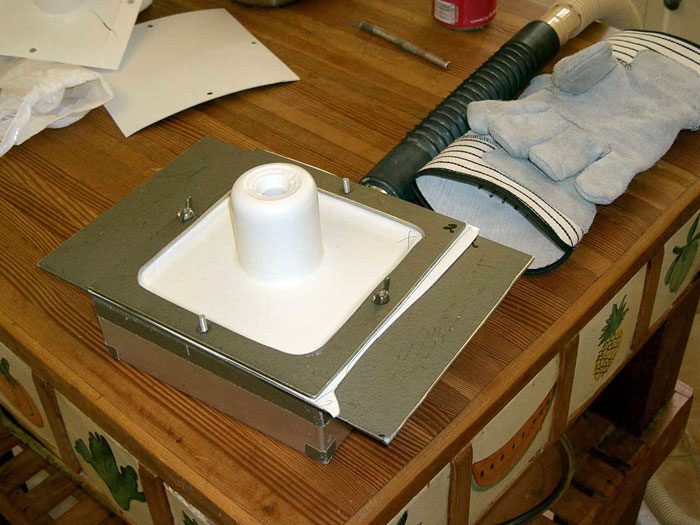
There were no armament or radios in the V1,
although holes were present in the wing spar and wing leading edge to
accommodate weapons. A new section had to be made for the area between
the cockpit and the cowling. The fin top had to be altered to get rid of
the antenna mast and add the place where an antenna would be located on
the V2.
The cockpit required some changes because it was, of course, wider,
since it was further forward. Because of that, the instrument panel was
also different from later 190s. I had only one fuzzy photo of the
mock-up panel, so went from there with my best guess. The prototype had
no discernable glare shield so that was removed. The canopy was
fortunately the same shape as the production aircraft, but was totally
clear, as opposed to the partially metal one in the later models. I just
glued the parts together, cleaned everything up, and used it to mold a
new canopy. More changes were needed on the deck area behind the seat.
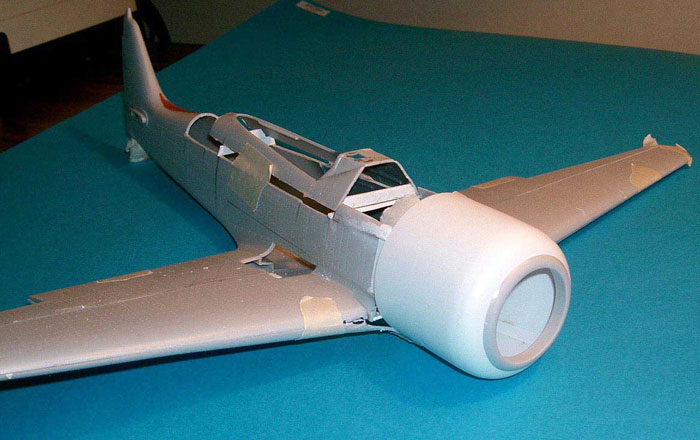
The kit spinner, prop, and the front portion of the engine was used with
relatively small changes being made (thankfully, the fan pretty much
hides the engine). The fan, however, had to be re-built because the V1
had ten, wider blades as compared to the production fan’s 12 blades. The
rudder was shortened in chord, and the tailwheel leg modified for a much
smaller wheel from the scrap box.
The wing required a bunch of work. First, based on the drawings and
information that I had, the V1’s wing was tapered to a greater degree
than the production versions, and was very slightly shorter. Therefore,
a wedge was removed from the wing beginning at each root and widening to
3/8” at the tip of each wing. A spar was cut from 1/8” styrene for
strength and to deal with the Airfix kit’s lack of dihedral. The wheel
wells were reconfigured to better match (I think) the prototype. The V1
used different nav lights, and all the armament lumps and bumps were
removed.
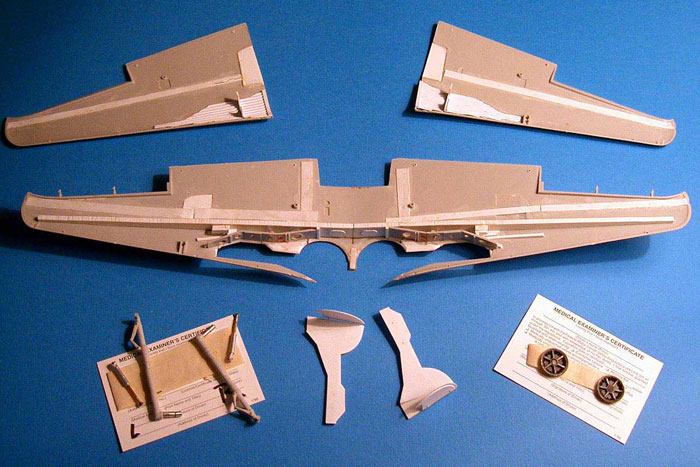
Because the gear door configuration was very different, new doors had to
be made and the openings in the wing had to be changed to match. A
couple of small jigs were made from cardboard to make sure that the gear
legs would end up at the correct angle(s). The retraction system was
also revised, since the prototype used hydraulic struts that were
connected directly to the legs, while the production versions used
electrical retraction. The V1 also used different wheels, but correct
ones from a long-deceased Me-109E were scrounged from the scrap box. The
torque links on the V1 were in front of the leg, so that had to be
changed.
As with nearly every short-nose 190 I have built over the years, the
area around the bottom of the wing and the cowling was a bit tricky to
handle. I found it to be worse on this model, because nearly every photo
shows that you could see daylight through the wells, and there were
struts coming from (I assume) the firewall and engines. The wells
themselves ran to the edge of the cowling. In other words, it was
greatly different from the kit. More fiddling, but it all came out in
the end, even though it was a bit like three-dimensional chess for a
while.
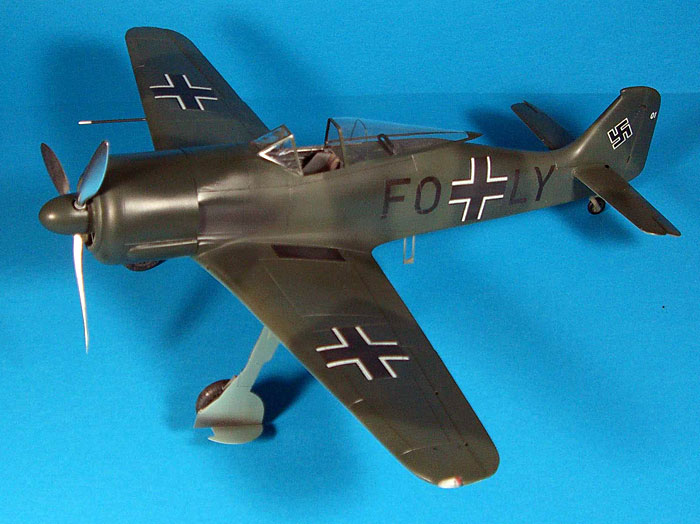
The entire model was re-scribed because it was apparent from the photos
and drawings that I had that few of the panel lines were the same as the
production aircraft. I also filled in most of the infamous rivets on the
kit, mostly out of necessity due to all the changes.
The model was painted in RLM 70/71/65. Although
some sources said that it was done in a splinter scheme, it is obvious
from photos that the divisions between the colors were (very) soft and
did not really seem to conform to any of the more common patterns (this
after all was a prototype). I therefore just more or less made it up as
I went along, since I had no photos of the top of the wings, except for
during construction, when they were still natural metal.

The markings were made on the computer (which I am a long way from
having perfected), and the code letters were done as a Word document,
which was then printed onto decal sheet.
Now, about those other two kits...
Focke-Wulf Fw 190
Modelling Manuals 20 |
|
|
|
|
US Price: $17.95
UK Price: £12.99
Publisher:
Osprey Publishing
Publish Date:
May 25, 2002
Details: 64 pages; ISBN: 1841762687 |
|
|
Model, Images and Text Copyright ©
2005 by Frank Mitchell
Page Created 22 November, 2005
Last Updated
22 November, 2005
Back to
HyperScale Main Page |
Home
| What's New |
Features |
Gallery |
Reviews |
Reference |
Forum |
Search